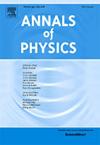广义几何-物质耦合引力中宇宙空洞及其物质性质在塑造虫洞几何中的作用
IF 3
3区 物理与天体物理
Q2 PHYSICS, MULTIDISCIPLINARY
引用次数: 0
摘要
宇宙空洞越来越被认为是一种很有前途的宇宙探索工具。它们的分布和密度曲线对引力理论的变化以及暗能量和中微子的影响都有很高的反应。研究空洞提供了一个引人注目的机会,可以在宇宙层面上发现其他引力模型的特征。空洞的密度对比范围显著,从中心附近的约- 1到边缘的约0,在那里筛选机制变得不那么有效。这项研究的主要目标是探索一种新的模型,该模型首次利用宇宙空洞(宇宙中巨大的低密度区域)引入了一种新的虫洞解决方案。我们专注于通过提出关于其物质含量的另一种观点来识别新的精确静态虫洞模型,这种观点植根于最近制定的f(R,Lm,T)引力理论。通过开发一个独特的解决方案,基于一个普遍的密度剖面的空洞,我们检查了关键的约束参数,决定物质分布和时空本身的结构。我们的研究结果揭示了这些宇宙空洞如何显著地影响虫洞的几何形状,使通向喉部的梯度变陡,减轻了对零能和弱能条件的违反,特别是在它们的中心之外。我们还强调了有趣的引力透镜效应,表明这个虫洞排斥光而不是捕捉光,在引力和光之间创造了一种迷人的相互作用。此外,我们使用TOV形式研究了解的稳定性,以及外来物质、外来性参数和各向异性对虫洞几何形状的影响。这些见解有助于更深入地了解低密度环境中的虫洞行为,以及宇宙空洞在虫洞形成过程中所起的关键作用。本文章由计算机程序翻译,如有差异,请以英文原文为准。
Role of cosmic voids and their matter properties in shaping wormhole geometry in generalized geometry-matter coupling gravity
Cosmic voids are increasingly recognized as a promising tool for cosmological exploration. Their distribution and density profiles are highly responsive to alterations in gravitational theories, along with the influences of dark energy and neutrinos. Investigating voids offers a compelling opportunity to uncover signatures of alternative gravity models on a cosmological level. Voids span a notable range of density contrasts, from approximately near their centers to around 0 at their edges, where screening mechanisms become less effective. The primary objective of this study is to explore a novel model that introduces a new category of wormhole solutions by leveraging cosmic voids – vast underdense regions of the universe – for the first time. We focus on identifying new exact static wormhole models by proposing an alternative viewpoint on their matter content, rooted in the recently formulated theory of gravity. By developing a unique solution based on a universal density profile for voids, we examine crucial constraints on the parameters that dictate matter distribution and the structure of spacetime itself. Our results reveal how these cosmic voids significantly influence the geometry of wormholes, steepening the gradient toward the throat and mitigating violations of the null and weak energy conditions, particularly beyond their centers. We also highlight intriguing gravitational lensing effects, showing that this wormhole repels light rather than capturing it, creating a fascinating interaction between gravity and light. Furthermore, we investigate the stability of the solution using the TOV formalism, along with the effects of exotic matter, the exoticity parameter, and anisotropy on wormhole geometry. These insights contribute to a deeper understanding of wormhole behavior in underdense environments and the pivotal role cosmic voids play in their formation.
求助全文
通过发布文献求助,成功后即可免费获取论文全文。
去求助
来源期刊

Annals of Physics
物理-物理:综合
CiteScore
5.30
自引率
3.30%
发文量
211
审稿时长
47 days
期刊介绍:
Annals of Physics presents original work in all areas of basic theoretic physics research. Ideas are developed and fully explored, and thorough treatment is given to first principles and ultimate applications. Annals of Physics emphasizes clarity and intelligibility in the articles it publishes, thus making them as accessible as possible. Readers familiar with recent developments in the field are provided with sufficient detail and background to follow the arguments and understand their significance.
The Editors of the journal cover all fields of theoretical physics. Articles published in the journal are typically longer than 20 pages.
 求助内容:
求助内容: 应助结果提醒方式:
应助结果提醒方式:


